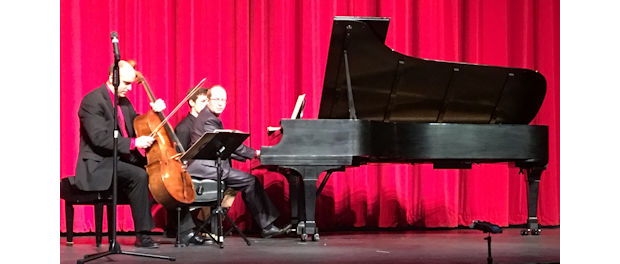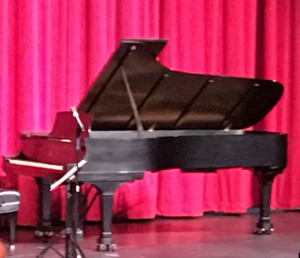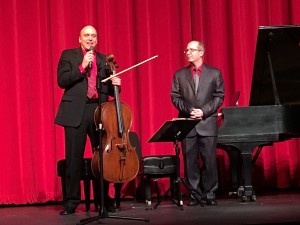Palzewicz-Tutunov Welcoming Spring Concert
 Cellist Michal Palzewicz and pianist Alexander Tutunov performing during one of their Welcoming Spring Concerts, at North Medford High School Auditorium on March 20, 2016.
Cellist Michal Palzewicz and pianist Alexander Tutunov performing during one of their Welcoming Spring Concerts, at North Medford High School Auditorium on March 20, 2016.
Palzewicz-Tutunov Welcoming Spring Concert: A Stunning Revitalization of Music To Mark The Season
– by Lee Greene
As everyone knows, “Spring is one of the four conventional temperate seasons, following winter and preceding summer.” [Wikipedia, Spring (season), https://en.wikipedia.org/wiki/Spring_(season)] Of course, that particular season, Spring, is fraught with a wagonload of associations, connotations and overtones: i.e., “ideas of rebirth, rejuvenation, renewal, resurrection and regrowth.” [Id.] Spring has been much written about by countless authors, generating volumes of prose and poetry about its beauty, regenerative powers, and role in the thread of life. It has also been the inspiration and topic for the creation of numerous musical compositions by many composers, attempting to depict the season and/or its connotations musically, including most famously, Beethoven (Violin Sonata in F Major, Op. 24, “Spring”), as well as Vivaldi (Spring from The Four Seasons), Schumann (Symphony No. 1 “Spring”), Rachmaninoff (Spring cantata), Britten (Spring Symphony), and many more. In many parts of the world and cultures, the onset of Spring is observed with celebrations and/or special events, recognizing the salutary attributes of spring. [Id.]
So it’s not surprising that a pair of internationally renowned virtuoso musicians, cellist Michal Palzewicz and pianist Alexander Tutunov, who happily for us reside in the Rogue Valley and experience the onset of Spring here (which officially arrived on March 21) with us, would decide that the coming of Spring is an apt occasion for a concert of classical music to celebrate the occasion. That the duo would honor the occasion, and their audience, by performing a concert is in itself a wonderful gift to classical music lovers here. But their Welcoming Spring Concert proved to be much more than just a lovely performance by a pair of world class musicians. They didn’t just plan a superb concert performance to mark the onset of spring. They took the true meaning of spring to heart, and produced something even greater. As contemporary American author, Gary Zukav, has written “spring wakes us, nurtures us, and revitalizes us.” [http://bit.ly/1UIVaFe] He has also written, “We cannot stop the spring or fall or make them other than they are. They are gifts from the universe that we cannot refuse. But we can choose what we will contribute to life when each arrives.” [http://bit.ly/1UJ35SS] What Messrs. Palzewicz and Tutunov chose to contribute to life, to the world, to the classical music repertoire, was a revitalization of the greatest piece of music celebrating spring, Beethoven’s Sonata in F Major, Op. 24 “Spring”. Messrs. Palzewicz and Tutunov labored for weeks to create an original transcription, a new adaptation, the first and only score of the masterpiece, written by the great maestro for violin and piano, for performance instead by cello and piano. And then they played it in a pair of concerts here, one in Ashland at the First United Methodist Church on March 18, and one in Medford at North Medford High School Auditorium on March 20. In effect, these concerts presented the world premiere of the Beethoven Sonata in F Major, Op. 24 “Spring” for Cello. It didn’t exist before; it had never been performed before, it was utterly new and it was glorious.
The original piece, as written by Beethoven, Sonata for Piano and Violin in F Major, Op. 24, “Spring” is
“One of the most popular of Beethoven’s sonatas . . . . The music is full of joy, and its refreshing, hopeful quality makes the subtitle, ‘Spring,’ most appropriate. Throughout, the melodies are immediate, simple, and elegant. There are also humorous moments, reminding listeners that Beethoven was a master of fun and games as well.” [Midori Gotō, http://bit.ly/1T7m3l7]
“Spring . . . . opens with one of the most unforgettable melodies of all time played in F Major by the violin. The second theme which follows is more rhythmic and energetic, and the movement develops around the two contrasting themes. The slow movement in B-flat Major speaks simply and flowingly, with violin and piano alternating in presenting the theme in slightly different variations. The third movement, a scherzo and trio, is like a game of tag in which the violin and the piano bounce off each other. The coquettish impression is strengthened by the rhythmic playfulness. The finale is in rondo form, with a lyrical theme followed by three episodes. Lighthearted and spontaneous, its dotted rhythms exemplify Beethoven’s inventiveness and sense of humor.” [Id.]
The new adaptation, for cello and piano, retained all of the remarkable attributes and qualities of the original, as just described by the violinist, Midori, but in this new performance replaced the higher pitched sounds of the violin with the deeper, richer, more resonant sounds of the cello. And not surprisingly, the two acclaimed virtuosi performed it masterfully. By the grace of God, I not only got to hear the performance, but was permitted to record some of it, so I have the privilege of being able to share a little of it with you. For embedding within this review, I have been permitted to share a minute excerpt from the Second movement, Adagio (described by Midori above as the “slow movement in B-flat Major”) from the March 20 performance:
If you would like to hear more, the recording of the entire Second movement (Adagio) from that performance has been made available to the public by the performers on Youtube at https://youtu.be/hHxNZgzM2sY but just can’t be embedded in a review, so you have to go to Youtube to hear it.
As you can hear and see for yourself, the piece is exquisitely beautiful, unforgettable, indeed a Beethoven masterpiece, once and always. And performed on a cello and piano, by this pair of top tier artists, its stunning, a revelation, a work of combined genius – adding that of Palzewicz and Tutunov on top of the incomparable Beethoven. It’s an honest to God musical rebirth, renewal, regrowth, a true musical spring.

The Sigmund Romberg Steinway piano, recently purchased by philanthropist James Collier for installation at The Manor’s Plaza in Medford, was used for the Welcoming Spring Concert.
I have much more to discuss about this concert, because, of course, the two accomplished artists presented a complete and substantial concert, encompassing a lot more than just the world premiere of their cello adaptation of Beethoven’s Spring Sonata in F Major. But before I go much further, and leave the astounding performance of the Beethoven Spring Sonata in F Major adaptation, I feel compelled to offer one more detail. To wit, it really has to be noted that the piano being played by Dr. Tutunov in this concert, for the Sonata adaptation, and everything else on the program, is the famed Sigmund Romberg Steinway piano, previously owned and used by the late composer Sigmund Romberg (1887-1951). The Romberg Steinway piano was recently purchased by local philanthropist, James Morrison Collier, and is soon to be installed as the piano at the Plaza of The Manor in Medford, but was used for this concert with his permission.
Now, about the rest of the Welcoming Spring Concert program. The duo played FIVE (5) additional pieces in the concert, besides the Beethoven Spring Sonata in F Major adaptation. They opened the concert with a performance of the Girolamo Frescobaldi Toccata, a lovely, lively piece supposedly written for keyboard in the 17th century and arranged for cello and piano by the great 20th century Spanish cellist and composer, Gaspar Cassado, although there is some controversy over the origin of the work, and question whether it may really have been wholly composed by Cassado himself rather than an arrangement of a Frescobaldi composition. [See Cello.org article on Cassado at http://bit.ly/1RB02vS] No matter. It’s a sprightly showpiece for both the cello and piano and a fine way to begin the concert, and display the prowess of the two performers.

Messrs. Palzewicz and Tutunov explain to audience the story of how they adapted Beethoven’s Sonata in F Major, Op. 24, for cello and piano, at Welcoming Spring Concert at North Medford H.S. Auditorium on March 20, 2016
Next the two artists spoke, providing an introduction to the Beethoven Spring Sonata in F Major adaptation, explaining that the idea was conceived by Dr. Tutunov, who suggested to Mr. Palzewicz that they attempt a cello transcription of the magnificent Spring-themed Beethoven violin sonata, to which Mr. Palzewicz promptly and emphatically responded “No!”. But then he thought better of it, and agreed to do it. It took them three long, labor intensive, hard weeks to get it done, they explained. Then the talking stopped, and they sat down and performed the piece, which was just shy of half an hour in length. Upon its conclusion, the audience responded with a rousing, spirited, standing ovation.
When things finally settled down, the pair launched into their final number before the intermission, At the Fountain, a piece for cello and piano composed by the renowned 19th century Russian cellist and composer, Karl Davydov. This again was another lively piece, with quick fast bowing on the cello, paired with equally rapid fingering on the piano keyboard. Taking notes in the audience, I couldn’t help but to scribble “Showoffs!” – I was beginning to think they had gone out of their way to pick pieces for this concert to display just how deft and fast they could play. Not that it wasn’t good – it was better than good. But they looked like they were trying to show off for the audience nonetheless. Since they certainly had the goods to show off, it’s only fair to allow them to show off for YOU too. So here’s the first minute and a half of Mr. Palzewicz and Mr. Tutunov performing Davydov’s At the Fountain:
After the intermission, the artists returned to the stage and began the second half of the concert by performing Dvorak’s Rondo for cello and piano. This is an entertaining piece that should be part of the standard repertoire of any concert cellist. [Antonin Dvorák: Rondo In G Minor Op. 94 (Cello & Piano), http://bit.ly/1RngIS3] Mr. Palzewicz can probably play it in his sleep. It was certainly entertaining, quite musical and melodic, with some lightning fingering on the cello in parts, but seemed like Mr. Palzewicz was showing off again – just because he could.
Following that, they got down to some serious business again, playing another Beethoven sonata, Sonata No. 4 in C major for cello and piano. Unlike the earlier played Spring Sonata, which was composed relatively early in Beethoven’s career, the Sonata No. 4 in C major for cello and piano was composed late in his life, when he was profoundly deaf. It is an extraordinarily complex composition and revolutionary in departing from the structure of earlier sonatas, of his own, and all the composers who preceded him. [Wikipedia, Cello Sonatas Nos. 4 and 5 (Beethoven), http://bit.ly/1pJQanA] This wasn’t really “showing off”, but rather a serious tackling of challenging material. The piece consists of two movements divided into a total of five sections, presenting a full variety of tempos, and eschewing most of the normal expected sonata structures, applying and experimenting with other forms, which have been compared “elsewhere in Beethoven’s work only in the drama of the fifth and ninth symphonies.” [Id.] No surprise though, that these two stars on their respective instruments were well up to the task, and performed an exceptional recital of the complex and challenging work. Once again, the audience was appreciative, and demonstrative in expressing it, upon the piece’s conclusion.
For the final piece listed on the concert program, Palzewicz and Tutunov played Bohemian cellist David Popper’s Dance of the Elves, “written to highlight the unique sound and style native to the cello extending the instrument’s range”. [Wikipedia, David Popper, http://bit.ly/1UmYINX] (Cellists showing off AGAIN!) The piece is something of a showpiece, employing fast, deft and precise work on both the cello AND the piano. It did create an impression – an entirely favorable one – as in wow, those fellows certainly can play, not only their own instruments well, but also tightly and precisely together. You can verify that for yourself with another sample, an excerpt from their performance of Dance of the Elves:
After much applause and multiple bows, they returned to their instruments for an encore: an absolutely lovely performance of Camille Saint-Saëns’s very familiar The Dying Swan. It is a wonderful piece of music, beautiful, calm, serene, and loved by almost everyone. Nice choice for an encore. Well played of course. Leaves everyone feeling happy, feeling good, and so they did. Quite a fantastic welcome to Spring. Can hardly wait to see/hear what they’ll have in store for Summer!

